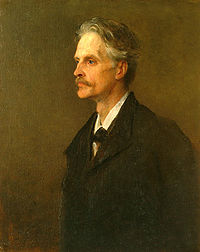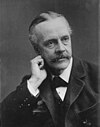| The Right HonourableThe Earl of BalfourPC | |
|---|---|
 Gerald Balfour in an 1899 portrait Gerald Balfour in an 1899 portrait by George Frederic Watts. | |
| President of the Board of Trade | |
| In office 12 November 1900 – 14 March 1905 | |
| Monarchs | Victoria Edward VII |
| Prime Minister | The Marquess of Salisbury Arthur Balfour |
| Preceded by | Charles Ritchie |
| Succeeded by | The Marquess of Salisbury |
| President of the Local Government Board | |
| In office 14 March 1905 – 4 December 1905 | |
| Monarch | Edward VII |
| Prime Minister | Arthur Balfour |
| Preceded by | Walter Long |
| Succeeded by | John Burns |
| Chief Secretary for Ireland | |
| In office 21 June 1895 – 9 November 1900 | |
| Monarch | Victoria |
| Prime Minister | The Marquess of Salisbury |
| Preceded by | John Morley |
| Succeeded by | George Wyndham |
| Member of the House of Lords Lord Temporal | |
| In office 19 March 1930 – 14 January 1945 as a hereditary peer | |
| Preceded by | The 1st Earl of Balfour |
| Succeeded by | The 3rd Earl of Balfour |
| Member of Parliament for Leeds Central | |
| In office 18 December 1885 – 8 February 1906 | |
| Preceded by | Constituency created |
| Succeeded by | Robert Armitage |
| Personal details | |
| Born | Gerald William Balfour (1853-04-09)9 April 1853 Edinburgh, Scotland |
| Died | 14 January 1945(1945-01-14) (aged 91) Whittingehame, Scotland |
| Nationality | British |
| Political party | Conservative |
| Spouse |
Lady Betty Bulwer-Lytton
(m. 1887; died 1942) |
| Children | 7 |
| Parent(s) | James Maitland Balfour Lady Blanche Gascoyne-Cecil |
| Alma mater | Trinity College, Cambridge |
Gerald William Balfour, 2nd Earl of Balfour, PC (9 April 1853 – 14 January 1945), known as Gerald Balfour or The Rt Hon. G. W. Balfour until 1930, was a senior British Conservative politician who became a peer on the death of his brother, former prime minister Arthur Balfour, in 1930.
Background and education
Balfour was born in Edinburgh on 9 April 1853, the fourth son of James Maitland Balfour, of Whittingehame, Haddingtonshire, and Lady Blanche Cecil, daughter of James Gascoyne-Cecil, 2nd Marquess of Salisbury. Two Prime Ministers were immediate relations: Arthur Balfour, 1st Earl of Balfour, his elder brother, and Lord Salisbury, his uncle. He was educated at Eton and at Trinity College, Cambridge, where he gained 1st Class Honours in the Classical Tripos.
Political career
Balfour sat as Conservative Member of Parliament for Leeds Central from 1885 to 1906. During this time he was a member of Commission on Labour, and private secretary to his brother, Arthur Balfour, when he was president of the Local Government Board from 1885 to 1886. He served as Chief Secretary for Ireland from 1895 to 1900, as president of the Board of Trade from 1900 to 1905 and as president of the Local Government Board in 1905. He was admitted to the Privy Council of Ireland in 1895, and to the Privy Council of the United Kingdom in 1905.
After losing his seat in the House of Commons in the Liberal landslide of 1906, he was chairman of the Commission on Lighthouse Administration in 1908, and chairman of the Cambridge Committee of the Commission on Oxford and Cambridge Universities. He succeeded his brother Arthur as second Earl of Balfour in 1930, according to a special remainder in the letters patent and took a seat in the House of Lords.
Personal life and academic honours
During his first spell at the Houses of Parliament, Balfour received an honorary LLD from Cambridge University, and was a fellow of Trinity.
From 1901 Balfour lived at Fisher's Hill House, a large home which he had built by Lutyens in Hook Heath, Woking, Surrey, also living in the rural hamlet by 1911 was Alfred Lyttelton (Lib. U.), Secretary of State for the Colonies (1903–1905) who married into his wider family and the Duke of Sutherland.
Balfour was interested in parapsychology. He was President of the Society for Psychical Research (1906–1907).
Marriage and children
Lord Balfour married Lady Elizabeth Edith "Betty" Bulwer-Lytton, daughter of the 1st Earl of Lytton, former Viceroy of India, in 1887. They had six children:
- Lady Eleanor Balfour (1890 – d. after 1980)
- Lady Ruth Balfour (d. 30 August 1967)
- Mary Edith Balfour (21 January 1894 – 1980)
- Lady Evelyn Barbara "Eve" Balfour (16 July 1898 – 1990)
- Robert Arthur Lytton Balfour, 3rd Earl of Balfour (31 December 1902 – 28 November 1968)
- Lady Kathleen Constance Blanche Balfour (1912 – 20 August 1996).
An affair with Welsh Liberal politician Winifred Coombe Tennant resulted in a further child, Augustus Henry.
The Countess of Balfour died in 1942, aged 74. Lord Balfour survived her by three years and died at Whittingehame on 14 January 1945, aged 91, by which time he was the last surviving member of any of long-serving Prime Minister Salisbury's cabinets. He was succeeded in the earldom by his only son Robert.
References
- ^ Oppenheim, Janet (2004). "Balfour, Gerald William, second earl of Balfour (1853–1945), politician and psychical researcher". Oxford Dictionary of National Biography (online ed.). Oxford University Press. doi:10.1093/ref:odnb/30556. (Subscription or UK public library membership required.)
- "Balfour, Gerald, William (BLFR871GW)". A Cambridge Alumni Database. University of Cambridge.
- H. E. Malden, ed. (1911). "Parishes: Woking". A History of the County of Surrey: Volume 3. Institute of Historical Research. Retrieved 20 November 2013.
- Pleasants. Helene. (1964). Gerald Balfour. In Biographical Dictionary of Parapsychology with Directory and Glossary 1946-1996. New York: Garrett Publications.
- Haynes, Renée. (1982). The Society for Psychical Research 1882-1982: A History. London: MacDonald & Co. p. 189. ISBN 978-0356078755
- Secret life story of psychic MP Winifred Coombe Tennant, BBC News, 18 May 2011
Further reading
- Gerald Balfour. (1908). Some Recent Investigations by the Society for Psychical Research. The Hibbert Journal. 7: 241–260.
- G. E. Cokayne; with Vicary Gibbs, H.A. Doubleday, Geoffrey H. White, Duncan Warrand and Lord Howard de Walden, editors, The Complete Peerage of England, Scotland, Ireland, Great Britain and the United Kingdom, Extant, Extinct or Dormant, new ed., 13 volumes in 14 (1910–1959; reprint in 6 volumes, Gloucester, UK: Alan Sutton Publishing, 2000), volume XIII, p. 373.
- Peter W. Hammond, editor, The Complete Peerage or a History of the House of Lords and All its Members From the Earliest Times, Volume XIV: Addenda & Corrigenda (Stroud, Gloucestershire: Sutton Publishing, 1998), p. 691.
- Charles Mosley, editor, Burke's Peerage and Baronetage, 106th edition, 2 volumes (Crans, Switzerland: Burke's Peerage (Genealogical Books) Ltd, 1999), volume 1, p. 173.
External links
- "Archival material relating to Gerald Balfour, 2nd Earl of Balfour". UK National Archives.

- Hansard 1803–2005: contributions in Parliament by the Earl of Balfour
| Parliament of the United Kingdom | ||
|---|---|---|
| New constituency | Member of Parliament for Leeds Central 1885–1906 |
Succeeded byRobert Armitage |
| Political offices | ||
| Preceded byJohn Morley | Chief Secretary for Ireland 1895–1900 |
Succeeded byGeorge Wyndham |
| Preceded byCharles Ritchie | President of the Board of Trade 1900–1905 |
Succeeded byThe Marquess of Salisbury |
| Preceded byWalter Long | President of the Local Government Board 1905 |
Succeeded byJohn Burns |
| Peerage of the United Kingdom | ||
| Preceded byArthur Balfour | Earl of Balfour 1930–1945 Member of the House of Lords (1930–1945) |
Succeeded byRobert Balfour |
| Arthur James Balfour, 1st Earl of Balfour | ||
|---|---|---|
| Premiership |  | |
| General elections | ||
| Constituencies | ||
| Family |
| |
| Career | ||
| In popular culture |
| |
| See also | ||
- 1853 births
- 1945 deaths
- Nobility from East Lothian
- Alumni of Trinity College, Cambridge
- Chief secretaries for Ireland
- Conservative Party (UK) MPs for English constituencies
- Members of the Privy Council of Ireland
- Members of the Privy Council of the United Kingdom
- British parapsychologists
- People educated at Eton College
- UK MPs 1885–1886
- UK MPs 1886–1892
- UK MPs 1892–1895
- UK MPs 1895–1900
- UK MPs 1900–1906
- UK MPs who inherited peerages
- Presidents of the Board of Trade
- Earls of Balfour
